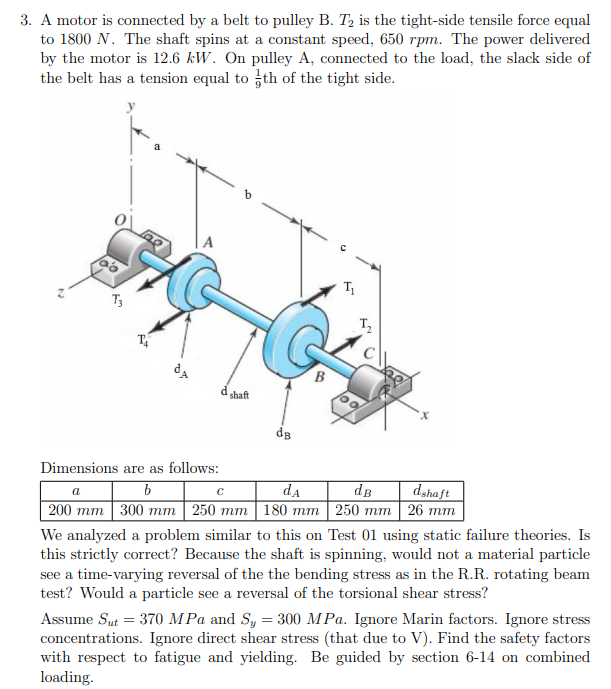3. A motor is connected by a belt to pulley B. T2 is the tight-side tensile force equal to 1800 N. The shaft spins at a constant speed, 650 rpm. The power delivered by the motor is 12.6 kW. On pulley A, connected to the load, the slack side of the belt has a tension equal to th of the tight side.
3. A motor is connected by a belt to pulley B. T2 is the tight-side tensile force equal to 1800 N. The shaft spins at a constant speed, 650 rpm. The power delivered by the motor is 12.6 kW. On pulley A, connected to the load, the slack side of the belt has a tension equal to th of the tight side.
Elements Of Electromagnetics
7th Edition
ISBN:9780190698614
Author:Sadiku, Matthew N. O.
Publisher:Sadiku, Matthew N. O.
ChapterMA: Math Assessment
Section: Chapter Questions
Problem 1.1MA
Related questions
Question
100%

Transcribed Image Text:3. A motor is connected by a belt to pulley B. T, is the tight-side tensile force equal
to 1800 N. The shaft spins at a constant speed, 650 rpm. The power delivered
by the motor is 12.6 kW. On pulley A, connected to the load, the slack side of
the belt has a tension equal to th of the tight side.
b
T
T,
B
d shaft
Dimensions are as follows:
da
200 тm 300 тт | 250 тm |180 тm | 250 тm 26 тm
dB
dahaft
a
We analyzed a problem similar to this on Test 01 using static failure theories. Is
this strictly correct? Because the shaft is spinning, would not a material particle
see a time-varying reversal of the the bending stress as in the R.R. rotating beam
test? Would a particle see a reversal of the torsional shear stress?
Assume Sut = 370 MPa and Sy = 300 MPa. Ignore Marin factors. Ignore stress
concentrations. Ignore direct shear stress (that due to V). Find the safety factors
with respect to fatigue and yielding. Be guided by section 6-14 on combined
loading.
Expert Solution
Step 1

Trending now
This is a popular solution!
Step by step
Solved in 5 steps with 5 images

Knowledge Booster
Learn more about
Need a deep-dive on the concept behind this application? Look no further. Learn more about this topic, mechanical-engineering and related others by exploring similar questions and additional content below.Recommended textbooks for you

Elements Of Electromagnetics
Mechanical Engineering
ISBN:
9780190698614
Author:
Sadiku, Matthew N. O.
Publisher:
Oxford University Press

Mechanics of Materials (10th Edition)
Mechanical Engineering
ISBN:
9780134319650
Author:
Russell C. Hibbeler
Publisher:
PEARSON

Thermodynamics: An Engineering Approach
Mechanical Engineering
ISBN:
9781259822674
Author:
Yunus A. Cengel Dr., Michael A. Boles
Publisher:
McGraw-Hill Education

Elements Of Electromagnetics
Mechanical Engineering
ISBN:
9780190698614
Author:
Sadiku, Matthew N. O.
Publisher:
Oxford University Press

Mechanics of Materials (10th Edition)
Mechanical Engineering
ISBN:
9780134319650
Author:
Russell C. Hibbeler
Publisher:
PEARSON

Thermodynamics: An Engineering Approach
Mechanical Engineering
ISBN:
9781259822674
Author:
Yunus A. Cengel Dr., Michael A. Boles
Publisher:
McGraw-Hill Education

Control Systems Engineering
Mechanical Engineering
ISBN:
9781118170519
Author:
Norman S. Nise
Publisher:
WILEY

Mechanics of Materials (MindTap Course List)
Mechanical Engineering
ISBN:
9781337093347
Author:
Barry J. Goodno, James M. Gere
Publisher:
Cengage Learning

Engineering Mechanics: Statics
Mechanical Engineering
ISBN:
9781118807330
Author:
James L. Meriam, L. G. Kraige, J. N. Bolton
Publisher:
WILEY